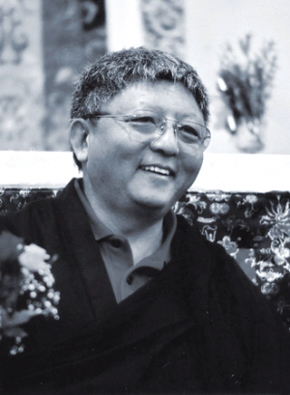 In 1975, at the beginning of H.H. the 16th Karmapa’s activity in the West, he appointed Lama Jigme Rinpoche to be his spiritual representative in Europe.
In 1975, at the beginning of H.H. the 16th Karmapa’s activity in the West, he appointed Lama Jigme Rinpoche to be his spiritual representative in Europe.
The lineage of the Karmapas was prophesied by the Buddha who said that approximately 1600 years after his passing, an emanation of the Boddhisattva of Compassion, Avalokiteshvara, would be born. ‚Karmapa’ literally means ‚man of Karma’, ‚man of action’, and his activity is to preserve and spread the essence of the teachings of all the Buddhas. The Buddha predicted that the Karmapa would propagate the teachings during the course of many successive incarnations.
The lineage of the Karmapas began in 1100, with the birth of Düsum Khenpa, who was a disciple of Je Gampopa. Before his passing on in 1193 he made a detailed prediction concerning the whereabouts of his next incarnation, thereby beginning the first of the so-called Tulku lineages of reincarnation in Tibet. A total of 16 reincarnations have followed since then. The 17th Karmapa, Trinley Thaye Dorje, spiritual head of the Karma Kagyu school, is currently living in Sikkim.
Ranjung Rigpe Dorje (1924 – 1981), travelled to Europe in the early seventies, where he was met with numerous requests for teachings and transmissions. Seeing that not only the time was right, but also that a specific structure was necessary for the successful promulgation of the teachings, Karmapa left precise instructions in the form of 5 wishes. He asked for the construction of a shedra (university), a library, a retreat centre, a monastery and the founding of Dharma centres throughout Europe.
The shedra is a place where people can come and receive teachings and study and practice the Dharma. For people wishing to intensify their practice and realize the profound meaning of the teachings, a retreat centre was necessary.
The library serves as a safeguard for the teachings, while the monastery is a home for qualified teachers and practitioners, some of whom travel to and share their knowledge in the Dharma centres throughout Europe.
These wishes have all been realized, and it is these wishes that represent the vision and activity of the Karmapa in Europe.
Lama Jigme Rinpoche was born in Kham, Eastern Tibet, in 1949. When the Chinese invaded in 1955, he moved to Tsurphu, the monastery of the Karmapas in Tibet, and eventually, in 1959, together with the Karmapa and many other high lamas and tulkus of all ages, he moved on to Rumtek in Sikkim. In Rumtek, H.H. the Karmapa founded a monastery in order to preserve the teachings, and it was there that, together with all the regents and important tulkus gathered there by the Karmapa, that Lama Jigme Rinpoche received all the transmissions directly from him.
In 1974, during his first visit to Europe, the Karmapa designated Dhagpo Kagyu Ling in Dordogne, France, to be the central seat of his activity, headed by Lama Jigme Rinpoche as his representative. He also asked Gendün Rinpoche and Pawo Rinpoche to go there and help in bringing the 5 wishes to fruition.
In addition to receiving all the main transmissions and teachings from the Karmapa, Lama Jigme Rinpoche was very close to and spent a lot of time with Gendün Rinpoche, Pawo Rinpoche, Kalu Rinpoche and Dilgo Kyentse Rinpoche, receiving many teachings and initiations from them as well.
Lama Jigme Rinpoche also received numerous important transmissions from Dudjom Rinpoche, the previous Sangye Nyenpa Rinpoche, the previous Khandro Rinpoche and the previous Gyatrul Rinpoche.
When H. H. the 16th Karmapa appointed Lama Jigme Rinpoche as his European representative, he said: ‚In the person of Lama Jigme Rinpoche, I leave you my heart’, and it is in this spirit that Lama Jigme Rinpoche today continues his activity in Europe, travelling extensively, visiting and teaching in the centres and inspiring all those who come into contact with him.
Source: www.jigmela.org




